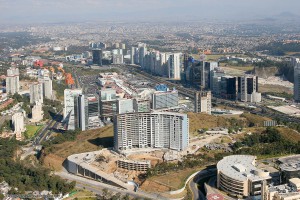Santa Fe, in upscale western Mexico City is one example of the many new developments being built on the urban periphery in Mexico.
The plan for the Santa Fe complex called for private sector financed office towers, a gigantic retail mall, high income housing, park areas, as well as schools and universities. Construction was halted briefly by the 1994–95 economic crises, but soon resumed at full speed. Today Santa Fe has numerous skyscraping office towers, over one eighth of the Federal District’s total office space, about 70,000 employees, four universities with 13,500 students, over 4300 residents, and one of the largest retail malls in Latin America.
Santa Fe is essentially an island that is only accessible by private car; public transport is relatively limited.
Unfortunately, it has not fully lived up to expectations. The preponderance of cars, mostly with a driver and no passengers, has led to severe traffic jams. Perhaps related to this, the vacancy rate of office space is about 25%. Furthermore, even with eight million visitors a year, the gigantic Santa Fe shopping mall is not as heavily utilized as competing malls in the area.
How many of the shoppers in Santa Fe mall or students attending classes realize that they are on top of what was once one of the biggest garbage dumps in Mexico City? Prior to its development into high-end real estate, much of this area had been quarried for sand, and the resulting holes used as a landfill site for household and industrial waste. Some of the structural problems reported in buildings in Santa Fe may well be due to the settling of these less than savory foundations.
(Our sincere thanks to Fatimah Araneta for improving this account)
If you have enjoyed this brief excerpt from chapter 23 of Geo-Mexico: the geography and dynamics of modern Mexico please consider purchasing your own copy of the book. Chapters 21 and 22 analyze Mexico’s 500-year transition to an urban society and the internal geography of Mexico’s cities. Chapter 23 looks at urban issues, problems and trends. To preview more parts of the book, click here and use amazon’s “Look Inside” feature.
2 Responses to “Santa Fe, a case study of a real estate development on the periphery of Mexico City”
Sorry, the comment form is closed at this time.

Love the wordpress theme you are utilizing. I reckon I may very well give suffusion a go myself in a completely new real-estate website. Thank you for the inspiration!
Yes, we are very happy with Suffusion; good luck with your new site.